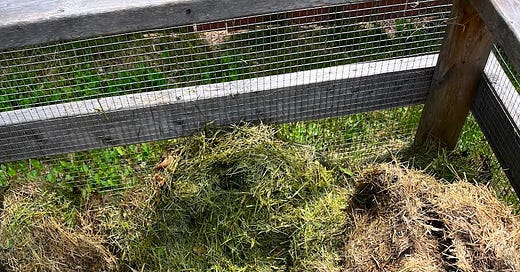On how to compost grass, a quickie edition
This reader question is one that I think a lot of people have.
I frequently get fun questions about compost from readers. Sometimes, I like to share them publicly.
Today’s query comes from one of my long-time and most-favorite subscribers, Kelsey B., who once also utilized my 3-bin compost blueprints to build herself a set of bins. (Pictured, in part, above.)
My answer has been edited and significantly expanded to make for proper educational material… I hope.
Q: Hey Cass!! Hope you & your piles are all doing splendidly. Do you have any advice on how to compost large quantities of grass clippings (as opposed to sod)? I recently got a push mower with a collection bag so I could dump all of the grass into my bin of browns / browns-in-progress, but have seen online that adding grass to an active pile can be dicey because it quickly starts producing ammonia. I haven't been sure on how quickly that process starts, but I just went to add some food scraps to my main pile and sure enough... cat pee stench.
I don't want the grass to go to waste, but I also don't want to mess with the pH of anything!
A: This is a great Q.
Knowing how a material will behave in the pile, as it breaks down, can help you consider how best, and in what quantities, to add it. Grass, for example, is a thin and structureless substance that lends itself to matting. Large amounts of it will compress easily, and when you have easy compression, you get anaerobic—and likely odorous—conditions. Therefore, you’ll want to make sure you’re adding large volumes of grass alongside materials that can help prevent compaction. Think: twigs, wood chips, torn cardboard, et cetera.
Add your grass in alternating layers with these other types of materials, and your pile should be fine.
That said, I get that it can feel exhausting, and sometimes frustrating, that every new material you add to your compost seems to require its own special rulebook. If that feeling is familiar to you, it can be helpful to keep in mind the broad operating principles of any pile:
Compost needs a balance of nitrogen and carbon, steady aeration, and consistent moisture. When you add a substance, like grass, that is easily-compressed, you’re challenging the pile’s fundamental need for “steady aeration.” (Compression = airless.) So you’ll want to make sure to add easily-compressed substances in combination with sturdier materials that help create air pockets, and thus keep airflow moving consistently throughout the pile.
Don’t just listen to me, though. Nothing beats your own nose for information. If you add a bunch of grass to your pile and it doesn’t smell, great. If it does, and you’ve tried adding some browns, and it still smells—add some more. Give things a turn. Check for overall moisture. (You want it to stay moist.) Give things a day between additions. See how it settles out. You’ll learn how much balance and airflow your pile requires over time, and through your own experimentation.
Keep the pile covered with a thick layer of odor-smothering sawdust or cardboard, in the interim, as a courtesy to your neighbors.
Got a question about your compost?
Respond to this email and let me know!





Your article is excellent information.
Another method I employ to help things “digest” is to have a dollar bag of cheap “topsoil” from Home Depot available to add a small shovel full of cheap soil to my bin. It cuts down on odors and prevents matting.
And if you don't have neighbors, go all in! :)